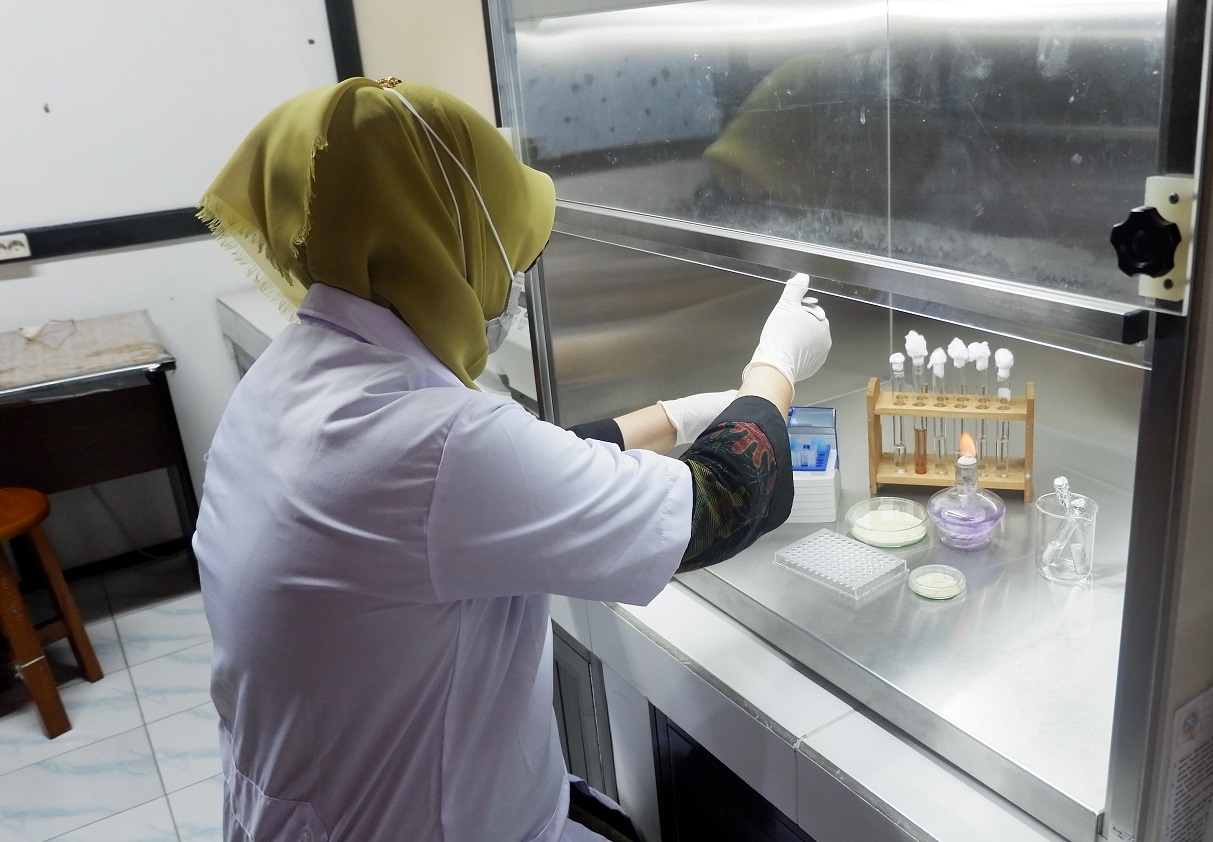UNAIR NEWS – Nowadays, Photodynamic Therapy (PDT) has been widely applied, such as in the treatment of dental diseases caused by bacteria. PDT is a method used to eliminate dangerous or undesirable cells such as cancer and bacteria causing infectious diseases.
The combination of light and certain photosensitiser in PDT will cause photoinactivation in bacteria, inhibition of cell metabolic activity due to cytoplasmic membrane damage from peroxidation by reactive oxygen. The mechanism of photoinactivation involves process of photosensitization, the absorption of light by photosensitizing molecules (porphyrins) in bacteria which in turn activates the chemical reaction to produce various reactive oxygen.
Photosensitisers are light-absorbing agents in PDT. Generally, the photosensitizer usually used is methylene blue. Various references showed that photosensitisers are toxic.
Inspired by it, Dr. Suryani Dyah Astuti, M.Si., with her research team from Faculty of Dental Medicine, Universitas Airlangga (UNAIR), Prof. Ernie Maduratna Setiawatie, used low-dose doxycycline as a photosensitizer.
Doxycycline is an antibiotic tetracycline drug that is used to treat some bacterial infections. Doxycycline in regular or daily doses is widely used because it has a broad spectrum of antibiotic efficacy effects. Compared to other types of tetracycline antibiotics, doxycycline has a broader range of Gram-negative and Gram-positive microbial types.
Giving low dose doxycycline for bacterial inactivation can minimize antibiotic side effects and prevent the bacteria from becoming resistant. The light absorption spectrum of doxycycline lies in the wavelength spectrum of visible light 380-780 nm so that it can be utilized as a photosensitizing agent.
Research Stages
Doxycycline research is conducted through in vitro, in vivo and clinical stages. At the in vitro stage, it was tested on dental disease (planktonic) bacteria and biofilms. The results showed that bacterial (planktonic) doxycycline 0.1% showed sensitive activity, while on biofilms showed resistance. It happened because doxycycline is not able to penetrate the pores of biofilms so a low dose would not be sensitive. The in vivo test in animal models of periodontitis using doxycycline and dentolaser showed a significant tissue improvement based on the results of anatomic histopathology (HPA).
In that study, the used doxycycline included two particle sizes, in micro and nano sizes. At micro-scale, doxycycline is diluted with distilled water while at the nanoscale, doxycycline is made into nanoscale mechanically, filtered and then diluted with distilled water.
“Justification of nanoscale size uses Particle Size analyzer (PSA) testing and infrared spectroscopy to determine the functional groups of each molecule. Absorbed spectrum testing with UV Visible spectroscopy showed a shift in wavelength from micro to nano, and the nanosize was able to absorb 67% of the light energy while at the nano size could reach 84%. The ability of light energy absorption is proportional to its effectiveness for bacterial inactivation, “explained the lecturer specialized in Biophysics and the Medical Physics Department of Physics Universitas Airlangga.
Research Method and Results
Dr. Dyah, added, the study conducted using doxycycline 0.1%, because at that dose the preliminary test results showed bacterial resistance and doxycycline acted as light-absorbing agents (photosensitiser). Doxycycline powder was dissolved in distilled water according to concentration, then incubated in bacterial culture dentolaser exposure was given.
The use of doxycycline 0.1% as photosensitiser with a dentolaser 405 nano meter (nm) activator showed better photoinactivation effectiveness compared to using doxycycline normally. The results of in vitro doxycycline research showed differences in the efficacy of each treatment. The use of lasers alone can reduce biofilms by around 31%. The use of doxycycline with lasers is around 60%, while nano doxycycline with lasers is 80%.
Based on the success of the in vitro and in vivo test results, the research was continued with clinical trials in the periodontitis case conducted by Prof. Ernie Maduratna S. The clinical trial results with doxycycline and dentolaser showed excellent results.
With this research, Dr. Dyah hoped that more innovation products will be produced in the future. Innovation does not have to be started from high technology, but simple things around us can be innovative and beneficial products for the community. “That is precisely what we need, especially for innovation breakthroughs in the world of health. so that medical costs can be affordable to the community, “she concluded. (*)
Author: Asthesia Dhea Cantika
Editor: Binti Q. Masruroh





